Hangul 전통차 Revised Romanization jeontongcha IPA [tɕʌn.tʰoŋ.tɕʰa] | Hanja 傳統茶 McCune–Reischauer chŏnt'ongch'a | |
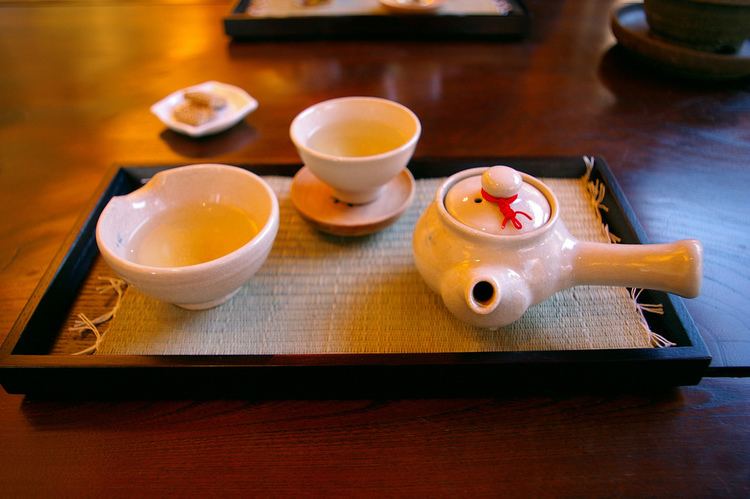 | ||
Traditional korean tea ceremony by yeonok kim
Traditional Korean tea, called traditional tea (Korean: 전통차) in Korea, is a drink made using infused leaves, flowers, fruits, grains, roots, and also some other ingredients such as edible mushrooms and seaweed or other parts of various plants. Although tea made from tea leaves is not as popular as coffee in South Korea (annual consumption 0.16 kg (0.35 lb) per capita, compared to 3.9 kg (8.6 lb) coffee), grain teas are served in many restaurants in place of plain water, and traditional teas made of various ingredients are commonly drunk both hot and cold.
Contents
- Traditional korean tea ceremony by yeonok kim
- Korean shaved ice at traditional korean tea house
- History
- Leaf teas
- Flower teas
- Fruit teas
- Grain been and seed teas
- Root shoot and bark teas
- Combination and other teas
- References
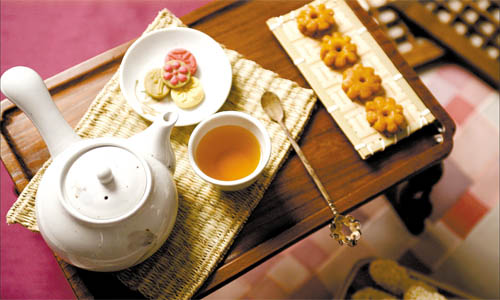
Korean shaved ice at traditional korean tea house
History
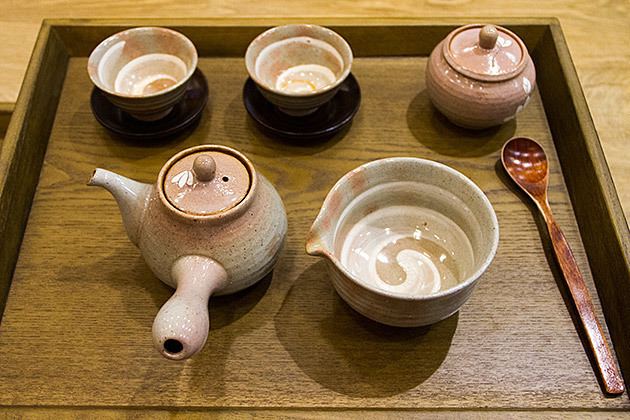
According to Record of Gaya cited in Memorabilia of the Three Kingdoms, the legendary queen Heo Hwang-ok, who was a princess of the Ayodhya married to King Suro of Gaya, brought the tea plant (Camellia sinensis var. assamica) from India and planted it in Baegwolsan, a mountain in current Changwon. However, Labrador tea and fruit teas such as omija-cha and gugija-cha were more common until the Samhan Era.
The first import of Chinese tea started during the reign of Queen Seondeok of Silla (631‒647), when two types of tea bricks, jeoncha (전차; 磚茶) and dancha (단차; 團茶), were imported from the Tang Empire. In 765, a Buddhist monk presented an offering to King Gyeongdeok and to Buddha. In 828, the small-leaved Chinese-type tea plant (Camellia sinensis var. sinensis) spread throughout the country via Buddhist temples.
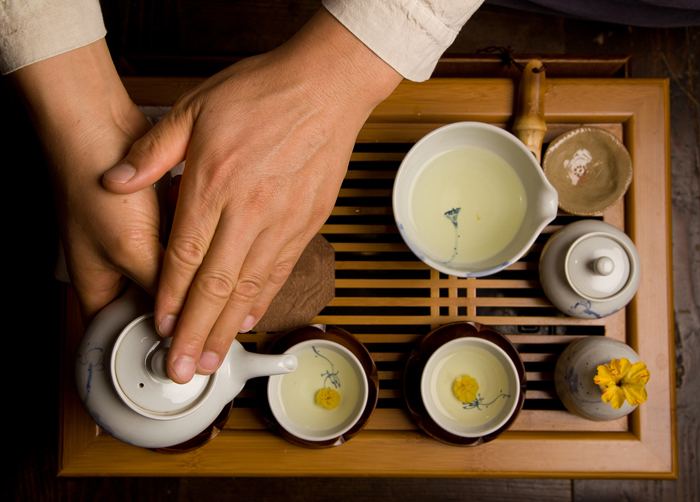
Tea culture prospered during the Goryeo Dynasty. Tea offering was a part of the biggest national ceremonies such as Yeondeunghoe and Palgwanhoe, and tea towns were formed around temples. During the reign of Myeongjong (1131‒1202), Seon-Buddhist manners of ceremony prevailed. Jeong Mongju and other scholars enjoyed tea poetry, dasi (다시; 茶詩), and tea meetings, dahoe (다회; 茶會). The state of daseonilchi (다선일치; 茶禪一致; "tea and seon in accord") was eulogized.
During the Joseon Dynasty (1392-1910), Korean tea culture underwent secularization along with the Korean culture itself. The royal family and the aristocracy used tea for simple rites. The word darye (다례; 茶禮}, "tea rite") is often translated as "etiquette for tea". Toward the end of the Joseon Dynasty, commoners joined the trend and used tea for ancestral rites. The word charye (차례; 茶禮}, "tea rite"), cognate to darye, now usually refers to jesa (ancestral rite). In the past, the two terms used to be synonyms as ancestral rites were often offerings of tea to the ancestors. Wedding ceremonies included tea offerings.
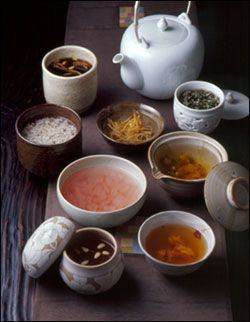
In 1985, King Gojong of Korean Empire enjoyed coffee for the first time. In 1896, grocery stores began to have tea rooms as an annex, and a modern tea house was first established in 1924.
In modern South Korea, the tea made of the tea leaves is not yet as popular as coffee. In 2016, the annual consumption per capita of green tea was 0.16 kg (0.35 lb), compared to 3.9 kg (8.6 lb) coffee. Commercial production of green tea in South Korea began in 1970s. Even in 2012, production of green tea in South Korea was 20% of Taiwan and 3.5% of Japan and tea consumption per capita is less than one tenth of other East Asian countries. Recently however, as the coffee market changed from a blue ocean to a red ocean, South Korean tea production doubled during 2010-2014, and the tea import doubled during 2009-2015 despite very high tariff rate (40% for black tea, and 513.6% for green tea, compared to 2% for raw coffee beans, and 8% for processed/roasted coffee).
Leaf teas
A tea made from the dried Korean pine needles that grows eastward. 50 grams (1.8 oz) of fresh pine needles are washed, drained, and boiled in 300 millilitres (11 imp fl oz; 10 US fl oz) water. When it comes to a boil, it is brewed on a low heat, and enjoyed without the leaves.
A tea made from peppermint.
A tea made from the dried leaves of Oriental persimmon. Young leaves are picked in May or June, washed, and dried for two to three days in shade. Dried leaves are usually cut into small pieces and steamed, and dried again. To make the tea, 2–3 grams (0.071–0.106 oz) of the dried leaves are brewed for 15 minutes in 100 millilitres (3.5 imp fl oz; 3.4 US fl oz) of water which was boiled and cooled to 70 °C (158 °F). A drop of maesil-ju (plum liquor) or yuja-cheong (yuja marmalade) can be added to the tea when served.
A tea made of partially oxidized leaves of tea plant. The tea, like oolong from China, is a cross between unoxidized green tea and fully oxidized black tea. The oxidation process for hwangcha is very specific to itself, which enables it to develop the unique flavour.
A tea made from the dried leaves of mountain hydrangea. The leaves are harvested from mid August to October and sun-dried.
A tea made from the dried leaves of rugose rose.
Green tea, the most common form of Korean leaf tea, is a tea made of the dried leaves of the tea plant. Nokcha can be classified into various types based on several different factors. The most common is flush, or the time of year when tea leaves are plucked: cheotmulcha (첫물차; "first flush"), ujeon (우전; 雨前; "pre-rain"), gogu (곡우; 穀雨; "grain rain"), sejak (세작; 細雀; "thin sparrow") or jakseol (작설; 雀舌; "sparrow tongue"), jungjak (중작; 中雀; "medium sparrow"), and daejak (대작; 大雀; "big sparrow") are the varieties.
Leaf tea is called yeopcha (엽차; 葉茶) or ipcha (잎차), while powdered tea is called malcha (말차; 末茶) or garu-cha (가루차). Leaf teas can be deokkeum-cha (덖음차; "roasted tea") or jeungje-cha (증제차; 蒸製茶; "steamed tea").
Southern, warmer regions such as Boseong, Hadong, and Jeju are famous for producing high quality tea leaves. Famous green teas include: Banya-cha (반야차; 般若茶; "prajñā tea"), Illohyang (일로향; 一爐香; "bamboo dew tea"), and Jungno-cha (죽로차; 竹露茶; "bamboo dew tea"). Nokcha can be blended with other ingredients, such as roasted brown rice to make hyeonmi-nokcha (현미녹차; 玄米綠茶; "brown rice green tea") or lemon to make remon-nokcha (레몬 녹차; "lemon green tea").
A tea made from the dried leaves of white mulberry.
A tea made from the dried needles of Korean red pine.
A tea made from dried Korean mugwort.
Flower teas
A tea made from dried peach blossoms.
A tea made from the dried flowers of pagoda tree.
A tea made from dried Indian chrysanthemum collected before fully opened. Before being dried, the flowers can be blanched in bamboo salt water, or steamed with water mixed with herbal decoction. Dried flowers can also be preserved in honey for three to four weeks to make honey chrysanthemum tea.
A tea made from the dried flowers of Chinese cinnamon.
A tea made from the dried flowers of various fruits of the genus Citrus, such as mandarin orange and byeonggyul.
A tea made from dried plum blossoms.
A tea made from the dried Korean dandelion.
A tea made from dried kobus magnolia flowers.
Fruit teas
A tea made from jujube. Blanched, deseeded, and thinly sliced jujubes are preserved in honey.
A tea made from dried goji berries.
A tea made from the dried rinds of various fruits of the genus Citrus, such as mandarin orange and byeonggyul.
A tea made from maesilcheong (plum syrup), which is made by sugaring ripe plums in honey.
A tea made from mogwacheong (quince preserve), which is made by preserving julienned Chinese quince in honey.
A tea made from five fruits, namely walnut, ginkgo, jujube, chestnut, and dried persimmon.
A tea made from dried magnolia berries. Omija means "five flavours", which are sweetness, sourness, bitterness, saltiness, and pungency.
A tea made from cornelian cherry.
A tea made from taengjacheong (hardy orange preserve), which is made by preserving sliced hardy oranges in honey.
A tea made from yujacheong (yuja marmalade), which is made by preserving peeled, depulped, and thinly sliced yuja in honey.
Grain, been, and seed teas
A tea made from roasted barley.
A tea made from roasted brown rice.
A tea made from roasted sicklepod seeds.
A tea made from roasted buckwheat.
A tea made from roasted mung beans.
A tea made from roasted corn kernels.
A tea made from roasted and powdered Job's tears.
Root, shoot, and bark teas
A tea made from boiling the dried roots of Korean angelica. The dried root is gently boiled in water for a few hours. Sometimes, ginger root can be added for preference when boiled. Korean angelica is often called ginseng for woman. Some believe that it is good for (white) leucorrhoea and postpartum care. If consumed for a long time, it can remedy cold fingers or toes. However, neither belief has been shown in independent scientific evaluations.
A tea made from dried roots of Solomon's seal.
A tea made from East Asian arrow root, which is a kind of kudzu.
A tea made from Chinese cinnamon bark.
A tea made from hongsam, the red ginseng.
A tea made from ginseng, which can be a fresh ginseng (수삼; 水蔘; susam), a dried ginseng (건삼; 乾茶; geonsam). The sliced or whole ginseng is boiled for a few hours, and then refined sugar (or unrefined sugar such as honey) may be added. A common ratio is 500 mℓ of water to 50 g of ginseng. Sometimes, jujube can be added when boiled. Some believe that insamcha is good for increasing energy, especially for someone who catches colds frequently in winter. It also has a remedial effect on stomachaches due to low body temperature. However, neither belief has been shown in independent scientific evaluations.
A tea made from Chinese yam.
A tea made from ginger. The ginger root is washed and sliced without peeling. The sliced ginger root is stored with honey for a few weeks. To make tea the mixed honey and ginger root is added to hot water. Some believe that Saenggangcha is useful to prevent colds and to aid digestion. It also has a remedial effect on diarrhea and stomachache due to low body temperature. It helps someone who has a low body temperature due to bad circulation. However, neither belief has been shown in independent scientific evaluations.
A tea made from burdock roots.
Combination and other teas
Mushroom teas are made from lingzhi (영지; 靈芝; yeongji), shiitake (표고; pyogo), oyster mushroom (느타리; neutari), and other edible mushrooms.
A tea made from kelp.
A tea made from the dried flesh or roasted seeds of winter melon.
A tea made by infusing northern dendranthema, goji berries, black sesame seeds, and jakseol (a type of nokcha) in boiling milk.
A tea made from the dried rinds of various fruits of the genus Citrus, such as mandarin orange and byeonggyul, with pyeongang (preserved ginger in honey).
A tea made from grapes, Korean pear, ginger, and honey.
A tea or a decoction made from a few materials of traditional Korean medicine such as dried roots of white woodland peony (백작약; 白芍藥; baekjagyak), steamed and dried roots of rehmannia (숙지황; 熟地黃; sukjihwang), dried roots of Mongolian milkvetch (황기; 黃芪; hwanggi), dried roots of Korean angelica (당귀; 當歸; danggwi), dried roots of lovage (천궁; 川芎; cheongung), Chinese cinnamon barks (계피; 桂皮; gyepi), and Chinese liquorice (감초; 甘草; gamcho). It is often translated as 'herb tonic tea.
A tea made from young watershield leaves collected in April, magnolia berry-infused water, honey, and pine nuts.
